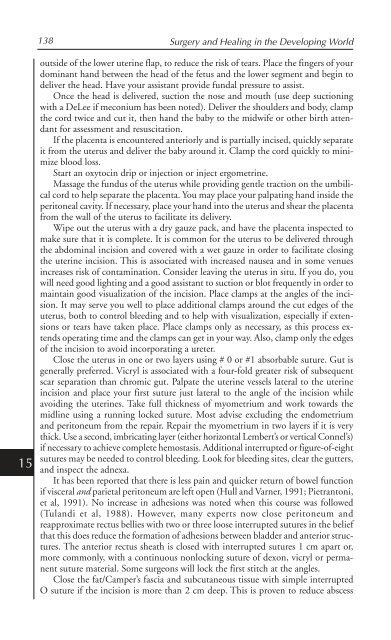Surgery and Healing in the Developing World - Dartmouth-Hitchcock
Surgery and Healing in the Developing World - Dartmouth-Hitchcock
Surgery and Healing in the Developing World - Dartmouth-Hitchcock
You also want an ePaper? Increase the reach of your titles
YUMPU automatically turns print PDFs into web optimized ePapers that Google loves.
15<br />
138 <strong>Surgery</strong> <strong>and</strong> <strong>Heal<strong>in</strong>g</strong> <strong>in</strong> <strong>the</strong> Develop<strong>in</strong>g <strong>World</strong><br />
outside of <strong>the</strong> lower uter<strong>in</strong>e flap, to reduce <strong>the</strong> risk of tears. Place <strong>the</strong> f<strong>in</strong>gers of your<br />
dom<strong>in</strong>ant h<strong>and</strong> between <strong>the</strong> head of <strong>the</strong> fetus <strong>and</strong> <strong>the</strong> lower segment <strong>and</strong> beg<strong>in</strong> to<br />
deliver <strong>the</strong> head. Have your assistant provide fundal pressure to assist.<br />
Once <strong>the</strong> head is delivered, suction <strong>the</strong> nose <strong>and</strong> mouth (use deep suction<strong>in</strong>g<br />
with a DeLee if meconium has been noted). Deliver <strong>the</strong> shoulders <strong>and</strong> body, clamp<br />
<strong>the</strong> cord twice <strong>and</strong> cut it, <strong>the</strong>n h<strong>and</strong> <strong>the</strong> baby to <strong>the</strong> midwife or o<strong>the</strong>r birth attendant<br />
for assessment <strong>and</strong> resuscitation.<br />
If <strong>the</strong> placenta is encountered anteriorly <strong>and</strong> is partially <strong>in</strong>cised, quickly separate<br />
it from <strong>the</strong> uterus <strong>and</strong> deliver <strong>the</strong> baby around it. Clamp <strong>the</strong> cord quickly to m<strong>in</strong>imize<br />
blood loss.<br />
Start an oxytoc<strong>in</strong> drip or <strong>in</strong>jection or <strong>in</strong>ject ergometr<strong>in</strong>e.<br />
Massage <strong>the</strong> fundus of <strong>the</strong> uterus while provid<strong>in</strong>g gentle traction on <strong>the</strong> umbilical<br />
cord to help separate <strong>the</strong> placenta. You may place your palpat<strong>in</strong>g h<strong>and</strong> <strong>in</strong>side <strong>the</strong><br />
peritoneal cavity. If necessary, place your h<strong>and</strong> <strong>in</strong>to <strong>the</strong> uterus <strong>and</strong> shear <strong>the</strong> placenta<br />
from <strong>the</strong> wall of <strong>the</strong> uterus to facilitate its delivery.<br />
Wipe out <strong>the</strong> uterus with a dry gauze pack, <strong>and</strong> have <strong>the</strong> placenta <strong>in</strong>spected to<br />
make sure that it is complete. It is common for <strong>the</strong> uterus to be delivered through<br />
<strong>the</strong> abdom<strong>in</strong>al <strong>in</strong>cision <strong>and</strong> covered with a wet gauze <strong>in</strong> order to facilitate clos<strong>in</strong>g<br />
<strong>the</strong> uter<strong>in</strong>e <strong>in</strong>cision. This is associated with <strong>in</strong>creased nausea <strong>and</strong> <strong>in</strong> some venues<br />
<strong>in</strong>creases risk of contam<strong>in</strong>ation. Consider leav<strong>in</strong>g <strong>the</strong> uterus <strong>in</strong> situ. If you do, you<br />
will need good light<strong>in</strong>g <strong>and</strong> a good assistant to suction or blot frequently <strong>in</strong> order to<br />
ma<strong>in</strong>ta<strong>in</strong> good visualization of <strong>the</strong> <strong>in</strong>cision. Place clamps at <strong>the</strong> angles of <strong>the</strong> <strong>in</strong>cision.<br />
It may serve you well to place additional clamps around <strong>the</strong> cut edges of <strong>the</strong><br />
uterus, both to control bleed<strong>in</strong>g <strong>and</strong> to help with visualization, especially if extensions<br />
or tears have taken place. Place clamps only as necessary, as this process extends<br />
operat<strong>in</strong>g time <strong>and</strong> <strong>the</strong> clamps can get <strong>in</strong> your way. Also, clamp only <strong>the</strong> edges<br />
of <strong>the</strong> <strong>in</strong>cision to avoid <strong>in</strong>corporat<strong>in</strong>g a ureter.<br />
Close <strong>the</strong> uterus <strong>in</strong> one or two layers us<strong>in</strong>g # 0 or #1 absorbable suture. Gut is<br />
generally preferred. Vicryl is associated with a four-fold greater risk of subsequent<br />
scar separation than chromic gut. Palpate <strong>the</strong> uter<strong>in</strong>e vessels lateral to <strong>the</strong> uter<strong>in</strong>e<br />
<strong>in</strong>cision <strong>and</strong> place your first suture just lateral to <strong>the</strong> angle of <strong>the</strong> <strong>in</strong>cision while<br />
avoid<strong>in</strong>g <strong>the</strong> uter<strong>in</strong>es. Take full thickness of myometrium <strong>and</strong> work towards <strong>the</strong><br />
midl<strong>in</strong>e us<strong>in</strong>g a runn<strong>in</strong>g locked suture. Most advise exclud<strong>in</strong>g <strong>the</strong> endometrium<br />
<strong>and</strong> peritoneum from <strong>the</strong> repair. Repair <strong>the</strong> myometrium <strong>in</strong> two layers if it is very<br />
thick. Use a second, imbricat<strong>in</strong>g layer (ei<strong>the</strong>r horizontal Lembert’s or vertical Connel’s)<br />
if necessary to achieve complete hemostasis. Additional <strong>in</strong>terrupted or figure-of-eight<br />
sutures may be needed to control bleed<strong>in</strong>g. Look for bleed<strong>in</strong>g sites, clear <strong>the</strong> gutters,<br />
<strong>and</strong> <strong>in</strong>spect <strong>the</strong> adnexa.<br />
It has been reported that <strong>the</strong>re is less pa<strong>in</strong> <strong>and</strong> quicker return of bowel function<br />
if visceral <strong>and</strong> parietal peritoneum are left open (Hull <strong>and</strong> Varner, 1991; Pietrantoni,<br />
et al, 1991). No <strong>in</strong>crease <strong>in</strong> adhesions was noted when this course was followed<br />
(Tul<strong>and</strong>i et al, 1988). However, many experts now close peritoneum <strong>and</strong><br />
reapproximate rectus bellies with two or three loose <strong>in</strong>terrupted sutures <strong>in</strong> <strong>the</strong> belief<br />
that this does reduce <strong>the</strong> formation of adhesions between bladder <strong>and</strong> anterior structures.<br />
The anterior rectus sheath is closed with <strong>in</strong>terrupted sutures 1 cm apart or,<br />
more commonly, with a cont<strong>in</strong>uous nonlock<strong>in</strong>g suture of dexon, vicryl or permanent<br />
suture material. Some surgeons will lock <strong>the</strong> first stitch at <strong>the</strong> angles.<br />
Close <strong>the</strong> fat/Camper’s fascia <strong>and</strong> subcutaneous tissue with simple <strong>in</strong>terrupted<br />
O suture if <strong>the</strong> <strong>in</strong>cision is more than 2 cm deep. This is proven to reduce abscess










